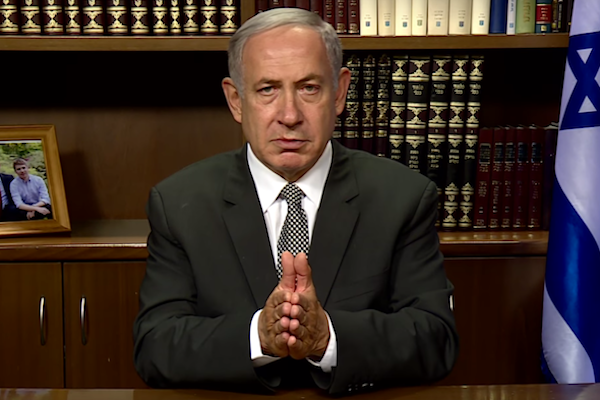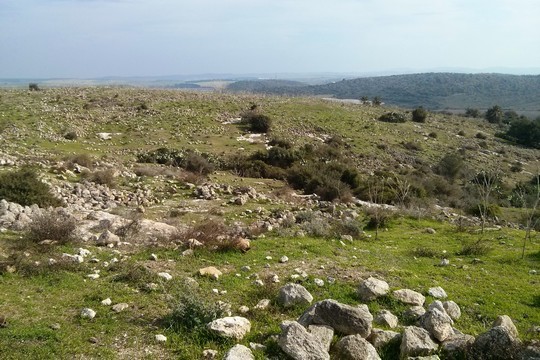By accusing Palestinians of attempting to ‘ethnically cleanse’ Jews, Netanyahu is not only distorting history, he is actively delegitimizing both the Palestinians and the Israeli Left.
By Na’aman Hirschfeld

“Ethnic cleansing is the forced removal of ethnic or religious groups from a particular territory with the intent of making it ethnically or religiously homogeneous. That’s the generally accepted definition of the phrase, and there are no differences of opinion on that.” These words were written by Moshe Arens in an op-ed published in Haaretz last month.
Arens went on to ask: “So why did Benjamin Netanyahu’s recent use of that phrase cause such an uproar?” After all, he argues, several ethnic cleansings have been carried out against Jews in Eretz Yisrael in the past, the last and largest one during the disengagement from Gaza, “when all Jewish settlers were forcibly removed from their homes. But that was a case where Jews uprooted Jews, you’ll say. Does that make it any less a case of ethnic cleansing? The objective of that “disengagement” was to leave the Gaza Strip without Jews.”
The questions raised by Arens should be addressed, because like Netanyahu’s claims, they are only made possible by a substantial lack of knowledge among Israelis about what “ethnic cleansing” actually is, and its relevance to the Israeli-Palestinian reality.
So what is ethnic cleansing? The Final Report of the Commission of Experts Pursuant to Security Council Resolution 780 (submitted in May 1994) — a seminal document vis-a-vis the definition of the term, asserts that ethnic cleansing:
… is a purposeful policy designed by one ethnic or religious group to remove by violent and terror-inspiring means the civilian population of another ethnic or religious group from certain geographic areas… [The] purpose appears to be the occupation of territory to the exclusion of the purged group or groups.
The violent means used in ethnic cleansing include: “murder, torture, arbitrary arrest and detention, extra-judicial executions, rape and sexual assaults, confinement of civilian population in ghetto areas, forcible removal, displacement and deportation of civilian population, deliberate military attacks or threats of attacks on civilians and civilian areas, and wanton destruction of property.” And since these acts are part of a coherent policy, the report asserts that: “Those practices constitute crimes against humanity and can be assimilated to specific war crimes. Furthermore, such acts could also fall within the meaning of the Genocide Convention.”
Following this definition, it is clear that Arens’ assertions are simply wrong: the violent events he describes could be considered as war crimes, but they were in no way instances of ethnic cleansing, i.e. of a coherent policy meant to “cleanse” an area of Jews. The only case of an explicit policy to remove Jewish civilians from a territory was the disengagement from Gaza.

Yet, the term “ethnic cleansing” is clearly false here as well. The displacement of the Jewish population during the disengagement was initiated and carried out by the State of Israel – the sovereign national ethno-religious entity to which the displaced population belongs as equal citizens. Furthermore its purpose was not the occupation of a territory but the exact opposite: the cessation of military occupation. Moreover the displacement was the result of a democratic process which included the participation of the displaced population and its supporters. Therefore it was a legal and legitimate action within the civil framework (the state) shared by both the displaced population and the displacing party. This is also true of the means of displacement, which included legally delimited, non-lethal coercion, employed only when other means failed, and with the full recognition that the displacement — be it willing or coerced — is injurious to the displaced population, as reflected in the restitutions given to the displaced.
In fact, anyone who understands the term “ethnic cleansing” simply would not use it in relation to the disengagement, unless that person was interested in creating negative propaganda. Such an effort was evident in the campaign conducted by those who opposed to the disengagement, which tried to rebrand the disengagement as the “uprooting” – a choice that is clearly evident in Arens’ text. Since that period, the hegemonic Israeli Right has been hard at work ingraining in the Israeli public collective consciousness the myth of “The Banishment from Gush Katif” — a myth modeled as a traumatic narrative, which following Israeli tradition, promotes political and economic interests and demands through self-victimizing demagoguery.
This is also true of Netanyahu’s viral video. As the “New Historians” showed, the most significant act of ethnic cleansing in Israeli-Palestinian history was planned and carried out by Israel against the Palestinians during its War of Independence – what came to be known as the Nakba. Yet the reality of ethnic cleansing is not in the past: following the aforementioned definitions, it is possible to assert that Israel continues to carry out ethnic cleansing in some areas of the occupied territories, specifically in areas near Jewish settlements. Netanayhu’s argument that the Palestinians wish to ethnically cleanse Jews was, in effect, meant to turn the tables on the Palestinians and simultaneously whitewash the settlements.

This is a calculated and particularly nasty maneuver in the propaganda war Israel is conducting against the Palestinians and the BDS movement. However, this maneuver is not aimed only or even primarily at international audiences. In fact, Israeli state propaganda, and Netanyahu’s in particular, is first and foremost directed at the Israeli public. It is part of the Right’s far-reaching revisionist effort, meant to delegitimize both the Palestinians and the Israeli Left in the intra-Israeli discourse, by positioning them as enemy forces bent on ethnically cleansing “us” — the Jews.
The discourse engineering efforts taking place in contemporary Israel, manifest throughout the public sphere, follows the classical Orwellian maxim: “Who controls the past, controls the future: who controls the present controls the past.” The cynical and instrumental rewriting of the past, as well as the extensive employment of negative propaganda, are clear markings of fascism.
Na’aman Hirschfeld is a PhD candidate at Humboldt University of Berlin’s Institute of Cultural Studies. This article was first published in Hebrew on Haokets. Read it here.



